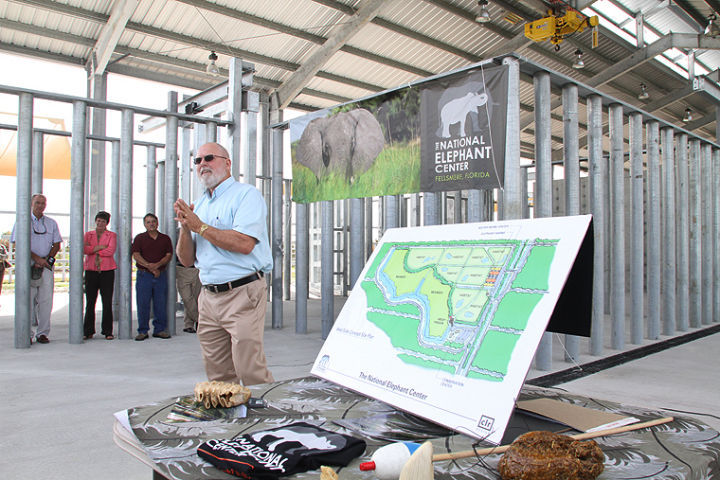
FELLSMERE — The National Elephant Center is nearly ready for the first pachyderms to arrive to its facility now that the elephant barn and keepers work center have been completed. When those first elephants will arrive remains unknown, though organizers estimate sometime this spring.
“We’re in discussions,” said Executive Director John Lehnhardt of talking with partner zoos. Nothing has been finalized. No contracts have been signed, nor have any reservations been made.
The National Elephant Center celebrated the completion of its elephant barn Wednesday, inviting local government leaders and board members to tour the facility.
Among those in attendance was the Massey family. Jason Massey, who works for Florida Power and Light, brought his wife and kids to the center. He helped coordinate the center’s receiving decommissioned wooden power poles and guy-wire.
The poles are expected to be used to create play structures for the elephants.
“I can picture them here,” Massey’s son Joah said, looking at the barn.
His brother, Javan, said he was surprised by how quickly the barn was built and that he was glad that elephants would have a place to go if they need medical care or other assistance.
“This is pretty awesome for Florida,” Melinda Massey said of attracting The National Elephant Center. “They’re intelligent animals that are probably misunderstood. They deserve a place to be cared for.”
That’s exactly the point of the Fellsmere facility.
“We really need this,” Lehnhardt said, addressing the assembled crowd in the barn. He said the facility is meant to ensure that elephants exist now and into the future.
Along with serving as a temporary residence for elephants while their home zoo undertakes renovations of their enclosure, The National Elephant Center will be a place for medical care, elephant handler training, elephant breeding, and, for some, a retirement home. On average, temporary residents are expected to stay a couple years.
Rick Barongi, out-going chairman, called the facility a “pachyderm paradise.”
“At least, I hope that’s what they (the elephants) call it,” he said.
To start, there is one open-air barn with nine stalls that can house nine elephants – or more as elephant compatibility permits. There are three large habitats complete with shade structures, watering holes, mud wallows, and other amenities to keep the elephants comfortable and entertained during their stay.
The next step for the center is to begin hiring, Lehnhardt said. Already, they have received between 40 and 50 applications. To start, just three will be hired. As the number of elephants grow, so, too, will the staff.
“I think they’ll all want to move to Fellsmere,” Lehnhardt said of the staff, which is expected to move to the area.
Staffers will use the keepers work center while on site. The building will serve a variety of purposes, from giving staff, volunteers and visitors a home base to storing vehicles and supplies. It will have locker rooms, restrooms and offices. The building’s back patio will also serve as a prime elephant-watching spot as it overlooks the barn and at least one of the habitats.
The center has a full 510 acres of land near the Sun Ag compound. When all phases are completed, there will be about 225 acres for the elephants to roam. Future phases include more barns and habitats, along with a visitors center and possible observation tower.
The visitors center and observation tower would be open to the general public, though the main facility would remain closed. Organizers are considering the possibility of opening the center itself to the public occasionally, but only once the facility is established.
Member zoos from the Association of Zoos and Aquariums have raised the seed money for the National Elephant Center, but donations are still needed. The organization is being run from the Brevard Zoo and a wish list of items, with cash being right at the top, is available at www.NationalElephantCenter.org.



